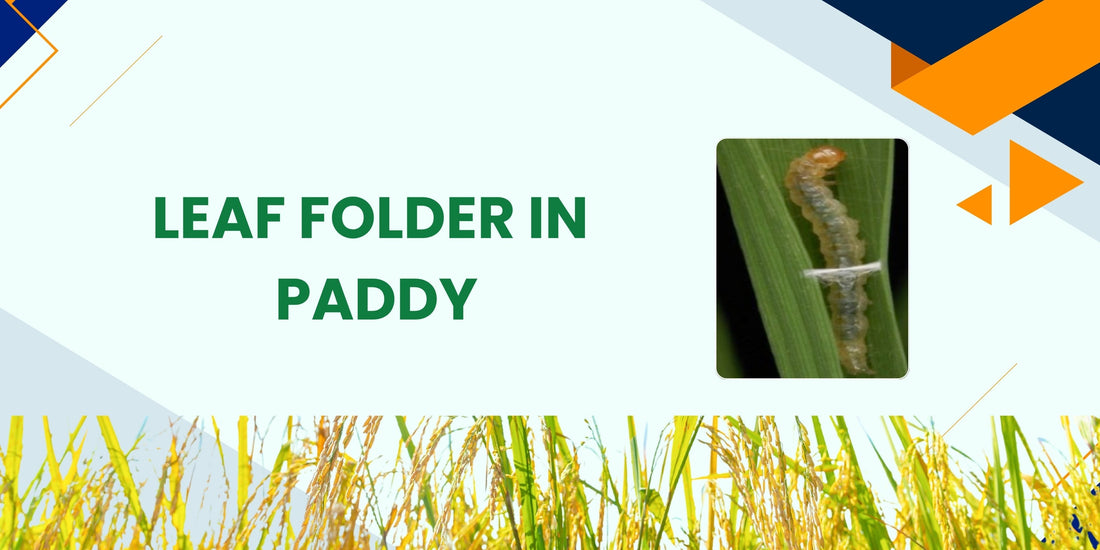
LEAF FOLDER IN PADDY
Telugu name: Aaku mudatha
Scientific name: Cnaphalocrocis medinalis
Identification of the pest:
Egg: Flat, oval in shape and yellowish white in colour.
Larva: Greenish translucent, prothoracic shield straight apically and rounded laterally.
Pupa: Pupal period is 7 to 10 days.
Adult: Moth is yellow brownish wings with many dark wavy lines in centre and dark band on margin of wings.
Lifecycle:
Rice leaf folder development undergoes four life stages: egg, larva, pupa and adult. It requires 24 days for complete development of life cycle passing through five instars [40]. Male and female moths are smaller in size and can be seen resting on walls near light sources after emergence.
Symptoms:
- Leaves folded longitudinally and larvae remain inside.
- Larvae scrape the green tissues of the leaves and become white and dry.
- During severe infestation the whole field exhibits whitish scorched appearance.
Favourable Conditions:
- Warm and humid weather favours the growth of pest.
- Shady areas of the field are favourable for the growth and development of leaf folder.
- More abundant during rainy season.
ETL: 10% leaf damage at vegetative phase and 5% of flag leaf damage at flowering.
Management:
Cultural practices:
- Use resistant varieties like, Cauveri, Akashi, TKM 6, TKM 12, ADT 46, TPS 2, TPS 3, ADT 44, PY 4, Kairali, Ahalya, kunju kunju varna, kunju kunju priya, Reshmi (PTB 44), Neeraja (PTB 47) and Deepthi.
- Keep the bunds clean by trimming them and remove the grassy weeds.
- Avoid use of excessive nitrogenous fertilizers.
- Avoid use of carbofuran (or) phorate granules to control resurgence of pests.
- Clipping of the affected leaves.
- Use of rope to dislodge the leaf feeding larvae of leaf folders.
- Open up the leaf folds with the help of a thorny twig.
Biological Control:
- Release Trichogramma chilonis (Egg Parasitoids) thrice on 37, 44 and 51 DAT @ 5 cc(1 lakh egg parasitoids)/ha/release.
- Release the egg cards in field during morning hours.
- Tie the egg cards under the leaf surface facing outside.
- Avoid spraying of chemicals three days before and upto seven days after field release of egg cards.
Trap methods:
- Set up light traps to attract and kill the moths. Set up light trap one for at least 5 ha.
- Set up bird perches (40 to 50/ha) of Insectivorous Birds at vegetative phase of crop.
- Monitor through phermone traps (@ 10 to 12/ha for timely control measures. Change the lure at 15-20 days intervals.
Chemical methods:
- The population should be estimated on the basis of careful and regular surveillance.
- When natural enemies of leaf folders are present, application of chemical measures can be delayed or dispensed with.
- In the initial stages restrict spraying to infested patches only. The field may be sprayed completely in case the infestation occurs uniformly.
- Spray any one of the following based on ETLs:
- Quinalphos 25 EC 1000 ml/ha (or) Dichlorvos 76 WSC 250 ml/ha (or)Chlorpyriphos 20 EC 1250 ml/ha (or) Carbaryl 50 WP 1.0 kg/ha.
- For Effective control of leaf folder use Biopesticide “LARVEX”@250 ml/acre.
FAQs:
1. What is the leaf folder in paddy and why is it a problem?
The leaf folder is a pest that damages paddy crops by folding leaves and feeding inside, reducing photosynthesis and yield. Early identification is key to controlling it.
2. What are the symptoms of leaf folder infestation?
Look for folded leaves, silk threads, and small caterpillars inside. Damaged areas appear white or translucent. Regular crop scouting helps spot them early.
3. What is the best time to monitor for leaf folders?
Inspect your fields during the early crop stages, especially in the morning or late afternoon when they are most active.
4. Are there natural ways to control leaf folders?
Yes! Encourage natural predators like spiders or introduce biocontrol agents like Trichogramma parasitoids. Healthy crop management also minimizes infestations.
5. What chemical solutions work against leaf folders?
We Insecticides like chlorantraniliprole or flubendiamide. Use them judiciously to avoid resistance. Always follow recommended dosages.For effective contol use Biopesticide LARVEX @250ml/acre.
6. How does water management affect leaf folder pests?
Overwatering creates a favorable environment for pests. Maintain proper water levels to reduce humidity, which discourages leaf folders.
